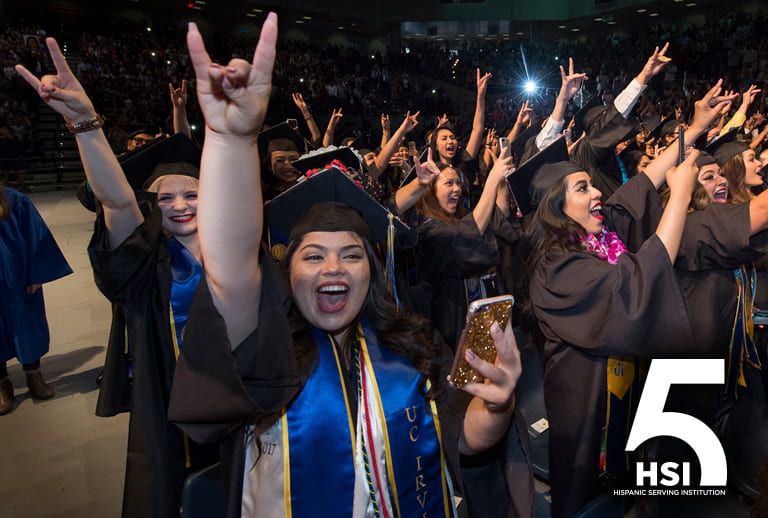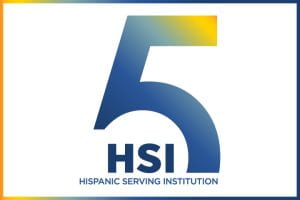HSI at 5
UCI celebrates its achievements as a federally designated Latino-serving campus

As an undergraduate at UCI majoring in biological sciences and working toward a preliminary teaching credential, Valeria Zavala had a simple career goal: to become a science teacher. But the journey to get there – which involved certification fees of up to $1,000 and accruing more than 500 student teaching hours without pay – was anything but easy.
Zavala had immigrated to the U.S. in middle school and studied hard to become the first in her family to attend college. Adversity was not new to her, but the hour-and-a-half-long bike rides to and from the elementary school she observed multiple times a week, on top of working part time to help support herself and her family, began to take a toll on her academics.
A Hispanic-Serving Institution grant – available only to universities with the federal HSI designation – alleviated her workload so she could concentrate on achieving her dreams. The UCI CalTeach program (funded by a different HSI grant) allowed Zavala to complete both a science degree and a teaching credential in just four years. The program, while rigorous, also enabled her to focus on her classes and student teaching by covering her transportation and certification exam costs.

Zavala, who graduated in 2019, is now a science teacher at a South Los Angeles middle school. And she isn’t the only student to benefit from an HSI grant. UCI has only been an HSI since 2017, but the effect of this designation is already immeasurable.
When UCI was named an HSI by the U.S. Department of Education, it became the second member of the elite Association of American Universities to achieve Hispanic-Serving Institution status. It also became the first AAU member to be both an HSI and an Asian American and Native American Pacific Islander-Serving Institution.
The university set a standard. Since then, four other AAU universities have joined UCI in attaining the HSI designation. Having this status also sent out a message that students from historically marginalized communities belong in elite institutions. Between 2008 and 2016, Hispanic undergraduate enrollment at UCI doubled, from 13 percent to 26 percent – a jump that coincided with increased admissions selectivity. As it became more difficult to get into UCI, the student body became more diverse.
For an institution to be labeled an HSI, at least 25 percent of its undergraduates must identify as Latino. But becoming an HSI means more than just setting Hispanic students on a path to success – the designation also reflects a wider net of support. To obtain HSI status, over one-third of all undergraduates must be Pell Grant recipients.
With UCI being an HSI, its faculty, staff and students may apply for grants, internships and partnerships that assist minority populations. “HSI grants are not just for Latinx students – they’re for everyone,” says Joseph Morales, associate director for strategic initiatives and partnerships in UCI’s Office of Inclusive Excellence. “Any faculty member can be eligible to pursue an HSI grant, and any student can be eligible to take part in a program supported by an HSI grant.”
But while being an HSI opens opportunities for targeted funding, at UCI, the title bears a deeper meaning. “Our work is not just limited to grants,” Morales says. “It’s something we can also do ourselves as a campus. It’s about the campus’s overall mission.”
Creating STEM pipelines
To nourish the academic success of Latino students, faculty and administrators have focused on increasing the number of Latino students graduating with science, technology, engineering and math degrees. In a campuswide self-study on HSI designation, for instance, 42 percent of non-Hispanic students who began as biological sciences majors earned a degree in that field, but only 24 percent of Hispanic students did.
Shortly after being awarded HSI status, UCI received $100,000 from the National Science Foundation to fund an HSI conference: “Pathways for Hispanic Students in STEM.” In January 2018, the event brought together 120 leaders in higher education to discuss improving retention and graduation rates for Latinos nationwide pursuing STEM degrees. Conference attendees were faculty and administrators from local high schools and two- and four-year colleges, emphasizing those that serve Latino students.
“Our goal, right from the beginning, was to be Hispanic-thriving, not just surviving,” says Michael Dennin, dean of UCI’s Division of Undergraduate Education and vice provost of teaching and learning. “HSI conference grants have allowed us to talk to other universities and build networks to make sure we’re approaching students in the right way. Rather than directly funding programs, these grants help inform how we design our programs.”
In 2019, UCI received $2.5 million from the NSF to improve the transition of community college students into university STEM programs. Another NSF HSI program provided almost $3 million to help UCI promote STEM degree completion by offering research-based sessions on how to foster more inclusive academic spaces.
Last year, the NSF awarded nearly $3 million over a five-year period to The Institute for Meaningful Engagement at UCI. This project explores the environmental factors that prompt minority students to leave STEM degree programs and investigates how faculty could strengthen inclusive cultures to retain them. A multidisciplinary group of campus leaders has joined with the deans of UCI’s six STEM schools to accomplish the goals and objectives of the project. Each of the six deans will nominate two faculty members to participate in TIME, and each cohort will receive two years of professional training on best practices in the classroom setting. The first dozen faculty members will meet this fall.
TIME leadership has also partnered with Santa Ana Community College to facilitate a version of TIME on its campus.
Pheather R. Harris, director of UCI’s California Alliance for Minority Participation and a principal investigator for TIME, hopes to see major changes by the end of the project.
“The first outcome is for faculty to recognize who they are in this conversation we’re having about inclusion and be able to have the tools they need to continue the work of enhancing inclusive spaces,” she says. “The second is for every single student to feel a sense of belonging, to feel seen and heard in their academic experience, and to achieve their full potential without the influence of the environment deterring them from their original goals and dreams.”
From Hispanic-serving to Hispanic-thriving
UCI is also committed to increasing the numbers of Latino graduate students and faculty. Over the past 10 years, the campus has nearly doubled its cohort of Latino Ph.D. students (from 217 to 416) and faculty (from 108 to 182). As of 2021, 7 percent of the faculty and 13 percent of doctoral students were Latino. But there is more to be done.
UCI recently became a founding member of the Alliance of Hispanic Serving Research Universities, which comprises 20 of the nation’s top research universities striving to enhance opportunities for those historically underserved by higher education.
“After years of working on its creation, I am thrilled that we can now announce this important alliance,” Chancellor Howard Gillman said in June. “We are all committed to using the distinctive characteristics of the Alliance of Hispanic Serving Research Universities to make rapid progress in advancing Hispanic student enrollment in doctoral programs and broadening pathways to the professoriate.”
The alliance aims to achieve two key goals by 2030: double the number of enrolled Hispanic doctoral students and increase by 20 percent the Hispanic professoriate in member universities.
Another Hispanic-serving alliance was recently initiated by the UCI Foundation’s board of trustees and campus administration. The UCI-OC Alliance works with schools and educational programs across campus to expand mentorships, internships and scholarships for UCI’s Latino population.
The alliance’s 31 founding members – including six UCI alumni – hail from such varied academic disciplines as business, law, public policy, media, education and the arts.
“Serving the Hispanic undergraduate population is the bare minimum,” Morales says. “Becoming an HSI means we also have to find ways to serve Latinx graduate students, staff and faculty. We have to find ways to permeate all levels of the campus ecosystem.”
From creating pathways for undergraduates to transition and succeed as graduate students to partnering with local community members, historically black colleges and universities, and tribal schools, UCI hopes to continue to build on its HSI status to not only help Hispanic students but, ultimately, all students who have been underserved by institutions of higher education.
“These opportunities are necessary because we come from families that work so hard to get us here, but when we are here – trying to work toward a career – we don’t know how to navigate the educational system and need guidance and encouragement to get us where we want to be,” says Estrella Estrada, who earned a B.A. in psychology and social behavior at UCI in 2017.
After graduation, she obtained a master’s degree in social welfare at UC Berkeley and is now a licensed clinical social worker in Solano County. She credits this outcome, in part, to UCI’s Student Success Initiatives, Student Outreach and Retention Center, and SAGE Scholars Program. In 2017, she was featured prominently in a video that UCI produced about its then-recent HSI designation.
“Many times, I felt like I couldn’t achieve a higher education or even attend a graduate program,” Estrada says, “but those counselors, staff members and programs helped me believe in myself and continue my journey. They were all so crucial to my success at UCI, especially as a Latina and first-generation college student.”


